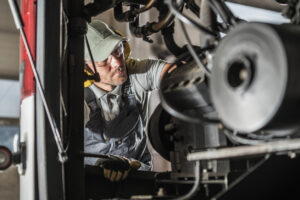Eddy Mullins has been training drivers for JB Hunt for 18 years, and he says new drivers are coming to him today with less and less in the way of navigational skills due to their over-reliance on GPS technology. (Courtesy: EDDY MULLINS)
Doesn’t it sometimes seem like people in trucking are constantly asking, “What direction is this industry headed?”
That’s a complicated question that encompasses a lot of long-range topics. Who can see that far ahead?
For now, Eddy Mullins is more concerned about drivers who can’t tell what direction their own trucks are headed.
Mullins has been training truck drivers for JB Hunt since 1999, shortly before GPS and smartphones exploded onto the market and changed how drivers navigate, or rather how they let themselves be navigated.
“When you sit up high in a truck, you can see people, those GPS’s everywhere,” Mullins said. “I see people who look lost, like they’re just waiting for that voice to say, ‘turn right in 500 feet.’
“Don’t get me wrong, I love my technology,” he added. “I’ve got my phone, I’ve got a tablet, I’ve got a bunch of electronic gadgets. But some things, you still need to do it the old way.”
But in the last few years, Mullins has noticed his job getting tougher, as new drivers are coming to him lacking skills that would have been almost taken for granted a generation ago.
“I started driving in 1995,” Mullins said. “When I first started we spent three whole days in class learning how to read a map and trip plan.
“Nowadays, they just say, ‘put the address in the GPS and go.’ I’ve trained some fairly new drivers and they’re like, ‘map? What’s a map? They never taught us that.’”
Maybe even more disturbing is that many new drivers seem to lack skills that are even more basic.
“I’ll ask them, ‘OK, the way we’re standing here right now, which direction are we facing? No, no, put the phone down. Which direction are we facing? If the sun rises over there, what does that tell you about what direction we’re facing?”
Part of Mullins’ job has become convincing new drivers not to be GPS dependent. ”I tell them, the GPS is only a tool,” he said. “You still need to plan your trips and don’t blindly rely on that thing. It can and will get you in trouble.”
Nearly anyone who’s used a GPS with any frequency has experienced some kind of snafu – the instruction to turn when there isn’t a road there, being taken around the block for no apparent reason, the sudden unannounced recalculation.
Yet people still hand navigational responsibility to their GPS, sometimes over their own senses and common sense. Occasionally, drivers who’ve taken this behavior to the extreme make the news after driving or almost driving into lakes, over cliffs and off roads and bridges that were closed for construction.
Mullins collects these stories along with pictures of trucks whose drivers allowed a GPS to lead them into embarrassing and sometimes dangerous situations to show his trainees.
“They’ll say, ‘what’s he doing on that walking path?’ I’ll say, ‘he was following his GPS. ‘What’s he doing on the [Atlantic City] boardwalk in a truck?’ ‘He was following his GPS. See what I’m getting at?’”
One common element to all of these stories is the drivers try to blame their predicament on the GPS. In many of these cases, the stories describe how the driver ignored warning signs, flashing lights and barricades in order to follow the machine’s verbal commands.
Mullins has seen and heard the same from drivers he’s trained. “They’re so focused on listening to that voice, they’re not aware of their surroundings. Like there’s a low bridge coming up, or, wait a minute, this is a neighborhood, what’s a truck doing in a neighborhood? ‘But the GPS says go this way.’ What about those big signs that say, ‘no trucks’?”
Researchers have shown that the saying, “it isn’t the destination, it’s the journey that matters” takes on new meaning when it comes to GPS use and its effect on drivers. There are definite use-it-or-lose it consequences from overreliance on the devices.
In 2016, a study at University College London compared brain activity between drivers given turn-by-turn instructions from a GPS and drivers on their own. The study found that when drivers used their own senses, there was a spike in activity in the parts of the brain responsible for navigation and planning.
No such increase in brain activity was recorded in the drivers who simply followed GPS directions.
Other studies have indicated that the more people depend on technology to lead them around, the less they retain their natural ability to navigate on their own, much the way muscles weaken from lack of exercise. A 2006 study of London cab drivers who’d navigated that city’s complicated streets for years found these drivers had above-average development in the area of the brain that processes spatial representation. The study also suggested that this pumped-up part of the brain starts to diminish once the drivers retire.
One of the key problems with GPS is its focus on an A-to-B route. The driver’s task is reduced to doing what the voice tells him to do. At this level of disengagement, the driver’s mind is prevented from what is called cognitive mapping, a combination of instinct and intellect that humans normally use to find their way around.
In the automotive age, cognitive mapping often begins with studying an actual map, plotting out a route, noting the towns you’ll pass through, the natural and manmade landmarks you’ll encounter.
Memory, vision and other cognitive functions all come into play while driving – reading the road signs, noting the landscape, creating your own mental landmarks.
Mullins advice to younger, beginning drivers is to take the time to learn how to use a map and an atlas along with your GPS. Learn the little things, too. He runs into many young drivers who were never taught that interstates with odd numbers run north-south, while those with even number run east-west. It’s these little things that can help you find your bearings when the tools have steered you wrong.
Even for veteran drivers, he said, it’s a good idea to check yourself now and then to make sure you haven’t fallen into the bad habit of blindly following that placid mechanical voice.
“Nothing is 100 percent,” he said. It’s still important to use the navigational tools you were born with because maps and atlases can be flawed, just like GPS instructions.
And if all else fails, he said, there’s an old-school, all-but-forgotten trick he learned back when he was a beginner and would get lost from time to time.
“It’s called stopping and asking the locals for directions.”
Klint Lowry has been a journalist for over 20 years. Prior to that, he did all kinds work, including several that involved driving, though he never graduated to big rigs. He worked at newspapers in the Detroit, Tampa and Little Rock, Ark., areas before coming to The Trucker in 2017. Having experienced such constant change at home and at work, he felt a certain kinship to professional truck drivers. Because trucking is more than a career, it’s a way of life, Klint has always liked to focus on every aspect of the quality of truckers’ lives.












